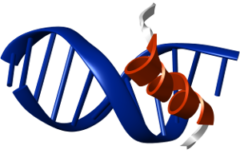19th Structural Biology Club of the Czech Society for Structural Biology
online on
29 November 2023, 13:00
with the following scientific talks kindly delivered by our guests
ABCF proteins function as master plumbers of the ribosome peptidyl transferase center
Presented by John F. Hunt, Department of Biological Sciences, Columbia University, New York, USA
The ABCF protein family comprises an extremely diverse group of putative mRNA translation factors within the ABC protein Superfamily. Proteins in this Superfamily use homologous ATP-Binding Cassette (ABC) domains to power a wide variety of biomolecular processes, many but not all of which involve transmembrane active transport. ABCF proteins have two tandem ABC domains in a single polypeptide chain that flank a conserved central domain (PF12848) called the P-Site tRNA Binding Motif (PtIM), and all representatives characterized to date have been shown to interact with the tRNA Exit (E) site of the ribosome. ABC proteins mediating similar biochemical functions generally have a significantly higher level of sequence identity to each other than to Superfamily members mediating different biochemical functions, which enables clustering into functional families based on sequence comparison. However, the sequence divergence between the ABC domains in ABCF family proteins can be as large as that between proteins in ABC families with completely different functions, suggesting that ABCF family members are likely to mediate many distinct biochemical functions related to mRNA translation. To gain insight into the spectrum of functions performed by ABCF proteins and the underlying physicochemical mechanisms, we have determined over a dozen different cryogenic electron microscopy (cryo-EM) structures for a dozen different ribosome complexes of the four ABCF paralogs encoded in the E. coli K12 genome. Analyses of our structures combined with structures of additional paralogs determined by other groups indicate that ABCF proteins generally control the stereochemistry of the interaction of the aminoacyl acceptor stem of the tRNA bound in the Peptidyl-tRNA Binding (P) site with the peptidyl transferase center (PTC) of the ribosome. Different ABCF proteins alternatively promote adoption of the proper catalytic geometry in the PTC, which can accelerate translation, or dramatically disrupt it, which is likely to function in resolving translational clogs caused by troublesome nascent peptide sequences or PTC-directed antibiotics. This “uncloggase” activity is likely to exploit a latent order-disorder transition in segments of the PTC and the Nascent Peptide Exit Tunnel (NPET). Our structural analyses furthermore explain how elevated ADP:ATP ratio, a key indicator of cellular energy status, can lead to ABCF-dependent ribosome pausing or hibernation. Finally, our analyses suggest that ABCF specificity is not likely to be determined by the stereochemistry in the PTC but rather primarily by the activation energy for the movement of the P-site tRNA induced by ABCF protein binding, which is coupled to adoption of the proper geometry for ATP hydrolysis by the protein’s ABC domains. These studies establish a framework to understand the mechanism and physiology of the myriad functional ABCF sub-families, which effectively function as master plumbers of the ribosome PTC.
Structural insights into eukaryotic ribosome-associated quality control (RQC)
Presented by Petr Těšina, Central European Institute of Technology, Masaryk University, Brno, Czech Republic
Ribosome-associated quality control (RQC) is a conserved process degrading potentially toxic truncated nascent peptides whose malfunction underlies neurodegeneration and proteostasis decline in aging. During RQC, dissociation of stalled ribosomes is followed by elongation of the nascent peptide with alanine and threonine residues, driven by Rqc2 independently of mRNA, the small ribosomal subunit and guanosine triphosphate (GTP)-hydrolyzing factors. The resulting CAT tails (carboxy-terminal tails) and ubiquitination by Ltn1 mark nascent peptides for proteasomal degradation. Here we present ten cryogenic electron microscopy (cryo-EM) structures, revealing the mechanistic basis of individual steps of the CAT tailing cycle covering initiation, decoding, peptidyl transfer, and tRNA translocation. We discovered eIF5A as a crucial eukaryotic RQC factor enabling peptidyl transfer. Moreover, we observed dynamic behavior of RQC factors and tRNAs allowing for processivity of the CAT tailing cycle without additional energy input. Together, these results elucidate key differences as well as common principles between CAT tailing and canonical translation.
Moderator: Gabriela Balíková Novotná, Institute of Microbiology, Czech Academy of Sciences, Vestec, Czech Republic
Please, join us on this Zoom link (join 5-10 minutes before the beginning)
https://cesnet.zoom.us/j/92170333913
Meeting ID: 921 7033 3913
